Abstract
The vibration dance was investigated in queenless (QL) colonies of honey bees. Workers performing the dance had significantly less-developed ovaries than recipients. Vibrators were more likely to be mauled by nestmates (an aggressive act) and were more strongly associated with foraging than were nonvibrating controls. Recipients responded to the dance by increasing the amount of time spent performing tasks. The vibration dance may therefore be associated with aggression in QL colonies and may give workers with less-developed ovaries a degree of control over the behavior of bees with greater ovarian development.
Similar content being viewed by others
References
Breed, M., and Gamboa, G. (1977). Behavioral control of workers by queens in primitively eusocial bees.Science 196: 694–696.
Bourke, A. (1988). Worker reproduction in the higher eusocial hymenoptera.Q. Rev. Biol. 63: 291–311.
Carlin, N., and Frumhoff, P. (1990). Nepotism in the honey bee.Science 346: 706–707.
Crosland, M. (1990). The influence of the queen, colony size and worker ovarian development on nestmate recognition in the antRhytidoponera confusa.Anim. Behav. 39: 413–425.
Evers, C., and Seeley, T. (1986). Kin discrimination and aggression in honeybee colonies with laying workers.Anim. Behav. 34: 924–925.
Fletcher, D. (1978). The influence of vibration dances by worker honeybees on the activity of virgin queens.J. Apic. Res. 17: 3–13.
Franks, N., and Scovell, E. (1983). Dominance and reproductive success among slave-making worker ants.Nature Land. 304: 724–725.
Frumhoff, P., and Schneider, S. (1987). The social consequences of honeybee polyandry: The effects of kinship on worker interactions within colonies.Anim. Behav. 35: 255–262.
Gahl, (1975). The shaking of the honeybee worker: evidence for age discrimination.Anim. Behav. 23: 230–232.
Gamboa, G., and Dew, H. (1981). Intracolonial communication by body oscillations in the paper wasp,Polistes metricus.Insectes Soc. 28: 13–26.
Hughes, C., and Strassmann, J. (1988). Age is more important than size in determining dominance among workers in the primitively eusocial wasp,Polistes instabilis.Behaviour 107: 1–14.
Jay, S. (1968). Factors influencing ovary development of worker honeybees under natural conditions.Can. J. Zool. 46: 345–347.
Korst, P., and Velthuis, H. (1982). The nature of trophallaxis in honeybees.Insectes Soc. 29: 209–221.
Markl, H. (1983). Vibrational communication. In Huber, F., and Markl, H. (eds.),Neuroethology and Behavioral Physiology: Roots and Growing Points, Springer-Verlag, New York, pp. 332–353.
Milum, U. (1955). Honeybee communication.Am. Bee J. 95: 97–104.
Nonacs, P. (1986). Ant reproductive strategies and sex allocation theory.Q. Rev. Biol. 61: 3–21.
Page, R., Jr., and Erickson, E., Jr. (1988). Reproduction by worker honey bees (Apis mellifera L.).Behav. Ecol. Sociobiol. 23: 117–126.
Page, R., Jr., Robinson, G., and Fondrk, M. (1989). Genetic specialists, kin recognition and nepotism in honey-bee colonies.Nature Land. 338: 576–579.
Reeve, H., and Gamboa, G. (1987). Queen regulation of worker foraging in paper wasps: A social feedback control system (Polistes fuscatus, Hymenoptera: Vespidae).Behaviour 102: 147–167.
Sakagami, S. (1953). Untersuchungen uber die Arbeitsteilung in einem Zwergvolk der Honigbiene. Beitrage zur Biologie des Bienenvolkes,Apis mellifera L.J. Jpn. J. Zool. 11: 117–185.
Sakagami, S. (1954). Occurrence of an aggressive behaviour in queenless hives, with considerations on the social organization of honeybees.Insectes Soc. 1: 331–347.
Schmid-Hempel, P. (1990). Reproductive competition and the evolution of work load in social insects.Am. Nat. 135: 501–526.
Schneider, S. (1986). The vibration dance behavior of successful foragers of the honeybee,Apis mellifera (Hymenoptera: Apidae).J. Kans. Entomol. Soc. 59: 699–705.
Schneider, S. (1987). The modulation of worker activity by the vibration dance of the honeybee,Apis mellifera.Ethology 74: 211–218.
Schneider, S. (1989). The dance behaviour of successful foragers of the African honey bee,Apis mellifera scutellata (Hymenoptera: Apidae).J. Apic. Res. 28: 150–154.
Schneider, S., Stamps, J., and Gary, N. (1986). The vibration dance of the honey bee. I. Communication regulating foraging on two time scales.Anim. Behav. 34: 377–385.
Seeley, T. (1989). The honey bee colony as a superorganism.Am. Sci. 77: 546–553.
Sokal, R., and Rohlf, F. (1981).Biometry, W. H. Freeman, San Francisco, pp. 1–859.
Strassmann, J., and Meyer, D. (1983). Gerontocracy in the social wasp,Polistes exclamans.Anim. Behav. 31: 431–438.
Velthuis, H. (1976). Egg laying, aggression, and dominance in bees.Proc. XV Int. Congr. Entomol, pp. 436–449.
Velthuis, H., and Gerling, D. (1983). At the brink of sociality: Interactions between adults of the carpenter bee,Xylocopa pubescens Spinola.Behav. Ecol. Sociobiol. 12: 209–214.
West-Eberhard, M. (1978). Temporary queens inMetapolybia wasps: nonreproductive helpers without altruism?Science 200: 441–443.
West-Eberhard, M. (1981). Intragroup selection and the evolution of insect societies. In Alexander, R., and Tinkle, D. (eds.),Natural Selection and Social Behavior, Chiron Press, New York, pp. 3–17.
Wilson, E. (1985). The sociogenesis of insect colonies.Science 228: 1489–1495.
Winston, M. (1987).The Biology of the Honey Bee, Harvard University Press, Cambridge, Mass., pp. 1–281.
Author information
Authors and Affiliations
Rights and permissions
About this article
Cite this article
Schneider, S.S., McNally, L.C. The vibration dance behavior of queenless workers of the honey bee,Apis mellifera (Hymenoptera: Apidae). J Insect Behav 4, 319–332 (1991). https://doi.org/10.1007/BF01048281
Accepted:
Issue Date:
DOI: https://doi.org/10.1007/BF01048281




